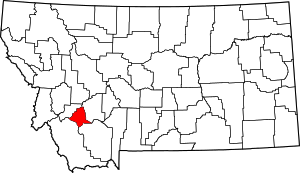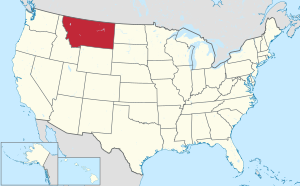Silver Bow County, Montana
 From Wikipedia - Reading time: 10 min
From Wikipedia - Reading time: 10 min
Silver Bow County | |
|---|---|
| Butte-Silver Bow County | |
 | |
 Location within the U.S. state of Montana | |
 Montana's location within the U.S. | |
| Coordinates: 45°54′N 112°40′W / 45.9°N 112.66°W | |
| Country | |
| State | |
| Founded | February 16, 1881 |
| Named after | Silver Bow Creek |
| Seat | Butte |
| Largest city | Butte |
| Government | |
| • Chief Executive | J.P. Gallagher |
| Area | |
• Total | 719 sq mi (1,860 km2) |
| • Land | 718 sq mi (1,860 km2) |
| • Water | 0.6 sq mi (2 km2) 0.08% |
| Population (2020) | |
• Total | 35,133 |
• Estimate (2022) | 36,068 |
| • Density | 49/sq mi (19/km2) |
| Time zone | UTC−7 (Mountain) |
| • Summer (DST) | UTC−6 (MDT) |
| Congressional district | 1st |
| Website | co |
| |
Silver Bow County is a county in the U.S. state of Montana. As of the 2020 census, the population was 35,133.[1] Its county seat is Butte.[2] In 1977, the city and county governments consolidated to form the single entity of Butte-Silver Bow. Additionally, the town of Walkerville is a separate municipality from Butte and is within the county.
Silver Bow County comprises the Butte-Silver Bow, MT Micropolitan Statistical Area.
Geography
[edit]According to the United States Census Bureau, the county has an area of 719 square miles (1,860 km2), of which 718 square miles (1,860 km2) is land and 0.6 square miles (1.6 km2) (0.08%) is water.[3] It is Montana's smallest county by area.
Major highways
[edit]Transit
[edit]Adjacent counties
[edit]- Deer Lodge County - northwest
- Jefferson County - east
- Madison County - south
- Beaverhead County - southwest
National protected areas
[edit]Beaverhead–Deerlodge National Forest (part)
Demographics
[edit]| Census | Pop. | Note | %± |
|---|---|---|---|
| 1890 | 23,744 | — | |
| 1900 | 47,635 | 100.6% | |
| 1910 | 56,848 | 19.3% | |
| 1920 | 60,313 | 6.1% | |
| 1930 | 56,969 | −5.5% | |
| 1940 | 53,209 | −6.6% | |
| 1950 | 48,422 | −9.0% | |
| 1960 | 46,454 | −4.1% | |
| 1970 | 41,981 | −9.6% | |
| 1980 | 38,092 | −9.3% | |
| 1990 | 33,941 | −10.9% | |
| 2000 | 34,606 | 2.0% | |
| 2010 | 34,200 | −1.2% | |
| 2020 | 35,133 | 2.7% | |
| 2022 (est.) | 36,068 | [4] | 2.7% |
| U.S. Decennial Census[5] 1790–1960,[6] 1900–1990,[7] 1990–2000,[8] 2010–2020[1] | |||
2020 census
[edit]As of the 2020 census, there were 35,133 people living in the county.[citation needed]
2010 census
[edit]As of the 2010 census, there were 34,200 people, 14,932 households, and 8,651 families living in the county. The population density was 47.6 inhabitants per square mile (18.4/km2). There were 16,717 housing units at an average density of 23.3 per square mile (9.0/km2). The racial makeup of the county was 94.4% white, 1.9% American Indian, 0.5% Asian, 0.3% black or African American, 0.1% Pacific islander, 0.7% from other races, and 2.1% from two or more races. Those of Hispanic or Latino origin made up 3.7% of the population. In terms of ancestry, 32.6% were Irish, 23.3% were German, 16.1% were English, 8.3% were Italian, 6.9% were Norwegian, and 3.2% were American.
Of the 14,932 households, 26.0% had children under the age of 18 living with them, 42.2% were married couples living together, 10.6% had a female householder with no husband present, 42.1% were non-families, and 35.1% of all households were made up of individuals. The average household size was 2.22 and the average family size was 2.87. The median age was 41.3 years.
The median income for a household in the county was $37,986 and the median income for a family was $52,288. Males had a median income of $41,491 versus $28,132 for females. The per capita income for the county was $21,357. About 11.6% of families and 17.8% of the population were below the poverty line, including 23.1% of those under age 18 and 8.9% of those age 65 or over.
Government and politics
[edit]Since 1977, Butte and Silver Bow County have been consolidated into one governmental body under the leadership of the chief executive and the council of commissioners. Elected in November 2020, J.P. Gallagher is the incumbent Chief Executive of Butte-Silver Bow, a nonpartisan office.[9]
A Democratic bastion, Silver Bow County is, along with neighboring Deer Lodge County, one of the two most consistently Democratic-voting counties in Montana in presidential elections, having last voted Republican in 1956 for Dwight D. Eisenhower. In 2024, Donald Trump, though still losing the county, became the first Republican to get within ten percent of carrying it since the aforementioned 1956 election.
Over the last century, Silver Bow County has voted only once for a Republican gubernatorial candidate (Marc Racicot during the 1996 election).[10] Silver Bow County has not supported any Republican at all for the U.S. Senate since at least 1928.[10]
Silver Bow County is in Montana Senate districts 36 (represented by Republican Jeffrey Welborn), 37 (represented by Democrat Ryan Lynch), 38 (represented by Democrat Edith McClafferty), and 39 (represented by Republican Terry Vermeire). In the Montana House of Representatives, the county is in districts 71 (represented by Republican Kenneth Walsh), 72 (represented by Republican Tom Welch), 73 (represented by Democrat Jennifer Lynch), 74 (represented by Democrat Derek J. Harvey), 76 (represented by Democrat Donavon Hawk), and 78 (represented by Republican Gregory Frazer).[11]
From 2024 to 2032, Silver Bow County will be in State Senate districts 35, 36, and 37, as well as State House of Representatives districts 70, 71, 72, 73, and 74. Two of the three Senate districts are expected to be favorable to Democrats as well as four of the five House districts.[12]
| Year | Republican | Democratic | Third party(ies) | |||
|---|---|---|---|---|---|---|
| No. | % | No. | % | No. | % | |
| 2024 | 8,110 | 44.50% | 9,386 | 51.50% | 730 | 4.01% |
| 2020 | 7,745 | 41.21% | 10,392 | 55.29% | 659 | 3.51% |
| 2016 | 6,376 | 38.76% | 8,619 | 52.39% | 1,457 | 8.86% |
| 2012 | 5,430 | 32.41% | 10,857 | 64.79% | 469 | 2.80% |
| 2008 | 4,818 | 28.27% | 11,676 | 68.51% | 548 | 3.22% |
| 2004 | 6,381 | 39.67% | 9,307 | 57.86% | 396 | 2.46% |
| 2000 | 6,299 | 37.71% | 8,967 | 53.68% | 1,437 | 8.60% |
| 1996 | 3,909 | 22.11% | 11,199 | 63.35% | 2,569 | 14.53% |
| 1992 | 3,491 | 19.24% | 9,960 | 54.89% | 4,695 | 25.87% |
| 1988 | 5,043 | 30.22% | 11,422 | 68.45% | 222 | 1.33% |
| 1984 | 6,637 | 36.85% | 11,095 | 61.60% | 278 | 1.54% |
| 1980 | 7,301 | 37.68% | 9,721 | 50.17% | 2,355 | 12.15% |
| 1976 | 7,506 | 39.28% | 11,377 | 59.53% | 227 | 1.19% |
| 1972 | 7,967 | 39.05% | 11,704 | 57.36% | 733 | 3.59% |
| 1968 | 5,488 | 27.98% | 12,626 | 64.36% | 1,503 | 7.66% |
| 1964 | 4,873 | 22.94% | 15,751 | 74.16% | 615 | 2.90% |
| 1960 | 7,290 | 34.40% | 13,754 | 64.91% | 146 | 0.69% |
| 1956 | 11,619 | 50.31% | 11,475 | 49.69% | 0 | 0.00% |
| 1952 | 10,196 | 43.46% | 13,114 | 55.90% | 148 | 0.63% |
| 1948 | 7,305 | 34.24% | 12,715 | 59.60% | 1,315 | 6.16% |
| 1944 | 7,610 | 36.17% | 13,228 | 62.87% | 202 | 0.96% |
| 1940 | 7,932 | 30.82% | 17,467 | 67.88% | 335 | 1.30% |
| 1936 | 4,528 | 20.02% | 17,697 | 78.23% | 398 | 1.76% |
| 1932 | 6,792 | 31.11% | 13,626 | 62.41% | 1,416 | 6.49% |
| 1928 | 9,456 | 44.81% | 11,228 | 53.21% | 419 | 1.99% |
| 1924 | 6,520 | 34.66% | 5,393 | 28.66% | 6,901 | 36.68% |
| 1920 | 10,074 | 55.36% | 6,394 | 35.14% | 1,730 | 9.51% |
| 1916 | 6,757 | 31.36% | 13,084 | 60.72% | 1,706 | 7.92% |
| 1912 | 2,232 | 18.76% | 4,542 | 38.18% | 5,122 | 43.06% |
| 1908 | 4,618 | 33.82% | 6,255 | 45.80% | 2,783 | 20.38% |
| 1904 | 5,149 | 36.07% | 5,686 | 39.83% | 3,439 | 24.09% |
| 1900 | 3,873 | 23.75% | 12,101 | 74.19% | 336 | 2.06% |
| 1896 | 1,275 | 11.29% | 9,992 | 88.46% | 29 | 0.26% |
| 1892 | 3,251 | 38.58% | 2,648 | 31.43% | 2,527 | 29.99% |
Communities
[edit]
City
[edit]- Butte (county seat)
Town
[edit]
Unincorporated communities
[edit]Education
[edit]Butte Public Schools has two components: Butte Elementary School District and Butte High School District.[15] Whitehall Public Schools has two components: Whitehall Elementary School District and Whitehall High School District.[16]
The consolidated city-county is covered by multiple school districts. High school districts include Butte High School District and Whitehall High School District. There are five elementary school districts: Butte Elementary School District, Divide Elementary School District, Melrose Elementary School District, Ramsay Elementary School District, and Whitehall Elementary School District.[17]
See also
[edit]- List of lakes in Silver Bow County, Montana
- List of mountains in Silver Bow County, Montana
- National Register of Historic Places listings in Silver Bow County, Montana
References
[edit]- ^ a b "State & County QuickFacts". United States Census Bureau. Retrieved April 5, 2023.
- ^ "Find a County". National Association of Counties. Retrieved June 7, 2011.
- ^ "2010 Census Gazetteer Files". United States Census Bureau. August 22, 2012. Archived from the original on December 5, 2014. Retrieved November 30, 2014.
- ^ "Annual Estimates of the Resident Population for Counties: April 1, 2020 to July 1, 2022". United States Census Bureau. Retrieved April 5, 2023.
- ^ "U.S. Decennial Census". United States Census Bureau. Retrieved November 30, 2014.
- ^ "Historical Census Browser". University of Virginia Library. Retrieved November 30, 2014.
- ^ "Population of Counties by Decennial Census: 1900 to 1990". United States Census Bureau. Retrieved November 30, 2014.
- ^ "Census 2000 PHC-T-4. Ranking Tables for Counties: 1990 and 2000" (PDF). United States Census Bureau. Archived (PDF) from the original on March 27, 2010. Retrieved November 30, 2014.
- ^ "Chief Executive". The City-County of Butte-Silver Bow. Retrieved July 3, 2023.
- ^ a b c David Leip. "Presidential Atlas". uselectionatlas.org. Retrieved April 2, 2018.
- ^ "Montana Legislature Information- 68th Session 2023 Regular". Montana Legislature. Retrieved July 3, 2023.
- ^ Kimbel-Sannit, Arren (February 13, 2023). "Explaining the why and the where of Montana's new legislative districts". Montana Free Press.
- ^ High View MT Google Maps (accessed January 7, 2019)
- ^ Williamsburg MT Google Maps (accessed January 7, 2019)
- ^ "Directory of Montana Schools". Montana Office of Public Instruction. March 13, 2024. pp. 264–265/317. Retrieved March 13, 2024.
- ^ "Directory of Montana Schools". Montana Office of Public Instruction. March 13, 2024. pp. 143/317. Retrieved March 13, 2024.
- ^ "2020 CENSUS - SCHOOL DISTRICT REFERENCE MAP: Silver Bow County, MT" (PDF). U.S. Census Bureau. Retrieved October 4, 2024. - Text list
 KSF
KSF